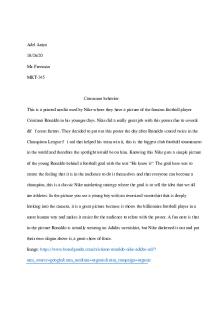Prosocial Behavior contd PDF

| Title | Prosocial Behavior contd |
|---|---|
| Course | Social Psychology |
| Institution | Florida State University |
| Pages | 3 |
| File Size | 115.6 KB |
| File Type | |
| Total Downloads | 41 |
| Total Views | 130 |
Summary
second half of prosocial behavior slides...
Description
● Environment ■ EX: Suppose you are walking down the street one day when you see a man suddenly fall down and cry out with pain. He rolls up his pants leg, revealing a bandaged shin that is bleeding heavily. What would you do? ■ Small towns: 50% the people who walked by stopped and offered to help the man ■ Large cities: Only 15% of the people who walked by stopped to help ■ What’s the stereotype about the helpfulness of people who live in New York City? ■ Urban overload hypothesis - people living in cities are constantly bombarded with stimulation and they keep to themselves to avoid being overwhelmed by it ■ Also consider: ● There is less anonymity in rural towns ● Diffusion of responsibility is less likely to occur ● Residential Mobility – how often you have moved ● BYSTANDER INTERVENTION MODEL ○ Bystander effect- The greater the number of bystanders, the less likely any one of them is to help ○ Latané & Darley, 1970 5-step model of bystander intervention… ■ Describes the steps that determine whether helping will occur in a bystander intervention situation ■ Step 1 Notice the event ● Problem: we often lack motivation/ability to help, or simply do not perceive help as being needed ● STEP 1 NOTICE THE EVENT ○ Darley & Batson, 1973 ○ Seminary students asked to give a talk, about either: ■ Good Samaritan parable ■ something else ○ They were either: ■ Late ■ on time ○ Passed a person slumped in a doorway
○ 63% of on time participants noticed and helped ○ 10% of late participants noticed and helped ○ Topic of speech had no effect ● STEP 2 INTERPRET SITUATION AS AN EMERGENCY ○ Pluralistic Ignorance - people think that everyone else is interpreting a situation in a certain way, when in fact they are not ○ Problem: emergencies are often ambiguous; informational social influence ○ Smoke room study ■ Participants complete survey alone or in groups of 3 ■ Experimenter pumps smoke into room ■ Who goes for help within 2 minutes? ● 50% of alone participants ● 12% of 3-person-groups ● Step 3 Assume responsibility to help ○ Problem: Diffusion of Responsibility – as the number of bystanders increases, each bystander’s individual sense of responsibility decreases ○ Would you stop someone from stealing a laptop if: ■ Asked to watch it vs. Simply witnessing it ○ Study ■ IV: Number of people in group (2, 3, or 6) ● One person in the group faked a seizure ■ DV: did people respond to help, and how quickly? ● Smaller groups responded more and faster ■ As Group Size Increased → Tendency to Seek Help Declined ● Step 4 Know how to help (i.e. have ability to help) ○ Problem: lack of knowledge of competence will prevent helping ○ Example: do you know CPR? ● Step 5 Decide to implement help (i.e. have the motivation to help) ○ Problem: costs to helping ○ Examples: Danger to self? Legal fears? Performance fears?
● Increasing Helping ○ Educate people about this research? ○ Yes. Research shows that this works. ■ Being aware of the barriers to helping in an emergency can increase people’s chances of overcoming those barriers. ■ People who know about bystander effects can realize that if they don’t act, perhaps no one will. ○ Single out individuals ○ Clearly define an event as an emergency ● REVIEW… ○ Theories of why we help ■ Evolution, social exchange, empathy-altruism hypothesis ○ Individual and situational factors that influence helping ○ Bystander intervention model ■ And all the problems that can prevent us from helping ○ How can we increase helping? ■ Educating the public...
Similar Free PDFs

Prosocial Behavior contd
- 3 Pages

What is prosocial behavior
- 1 Pages

PSY362-RS-Prosocial Behavior
- 3 Pages

Prosocial Behaviour
- 91 Pages

Prosocial - lecture
- 6 Pages

Types Of Series (contd)
- 6 Pages

Dunn, aknin, norton prosocial cdips
- 19 Pages

Behavior contracts
- 3 Pages

Consumer behavior
- 5 Pages

Deviant Behavior
- 3 Pages

Organizational Behavior
- 39 Pages

Prioritizing Behavior
- 7 Pages

Defining Behavior
- 4 Pages
Popular Institutions
- Tinajero National High School - Annex
- Politeknik Caltex Riau
- Yokohama City University
- SGT University
- University of Al-Qadisiyah
- Divine Word College of Vigan
- Techniek College Rotterdam
- Universidade de Santiago
- Universiti Teknologi MARA Cawangan Johor Kampus Pasir Gudang
- Poltekkes Kemenkes Yogyakarta
- Baguio City National High School
- Colegio san marcos
- preparatoria uno
- Centro de Bachillerato Tecnológico Industrial y de Servicios No. 107
- Dalian Maritime University
- Quang Trung Secondary School
- Colegio Tecnológico en Informática
- Corporación Regional de Educación Superior
- Grupo CEDVA
- Dar Al Uloom University
- Centro de Estudios Preuniversitarios de la Universidad Nacional de Ingeniería
- 上智大学
- Aakash International School, Nuna Majara
- San Felipe Neri Catholic School
- Kang Chiao International School - New Taipei City
- Misamis Occidental National High School
- Institución Educativa Escuela Normal Juan Ladrilleros
- Kolehiyo ng Pantukan
- Batanes State College
- Instituto Continental
- Sekolah Menengah Kejuruan Kesehatan Kaltara (Tarakan)
- Colegio de La Inmaculada Concepcion - Cebu


